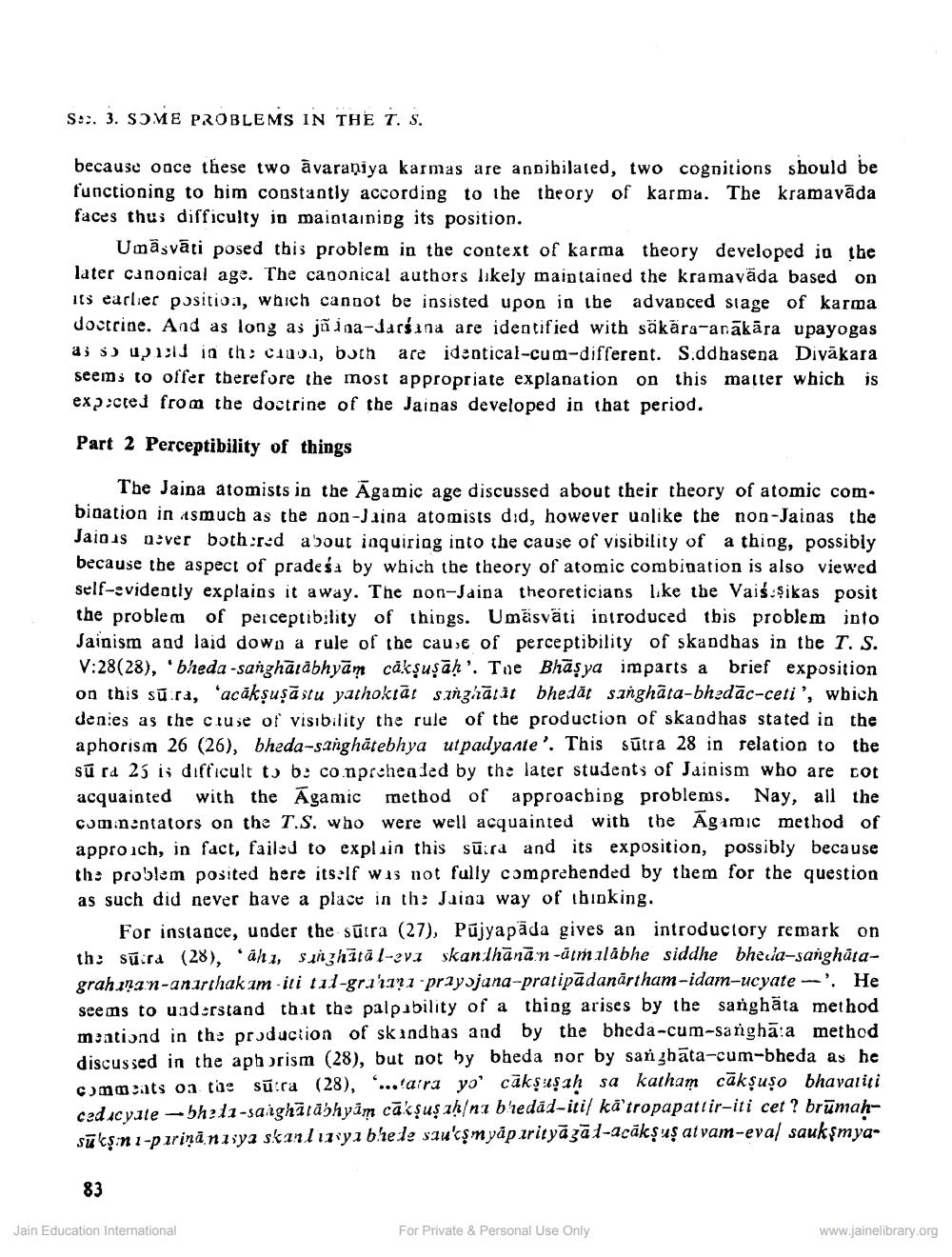________________
S... 3. SOME PROBLEMS IN THE T. S.
because once these two āvaraniya karmas are andibilated, two cognitions should be functioning to him constantly according to the theory of karma. The kramavāda faces thus difficulty in maintaining its position.
Umäsvāti posed this problem in the context of karma theory developed in the later canonical age. The canonical authors likely maintained the kramavāda based on 11s earlier position, which cannot be insisted upon in the advanced stage of karma doctrine. And as long as jõina-Jarsina are identified with säkära-arākāra upayogas aj s) und in th: cao, buth are identical-cum-different. Siddhasena Divākara seems to offer therefore the most appropriate explanation on this matter which is ex.cted from the doctrine of the Jainas developed in that period.
Part 2 Perceptibility of things
The Jaina atomists in the Āgamic age discussed about their theory of atomic com. bination in asmuch as the non-Jaina atomists did, however unlike the non-Jaioas the Jaigas never both:red about inquiring into the cause of visibility of a thiog, possibly because the aspect of pradesa by which the theory of atomic combination is also viewed self-evidently explains it away. The non-Saina theoreticians like the Vais:sikas posit the problem of perceptibility of things. Umäsväti introduced this problem into Jainism and laid down a rule of the cause of perceptibility of skandhas in the T. S. V:28(28), 'bheda-sanghātābhyām cakşuşāh'. Toe Bhäsya imparts a brief exposition on this süira, 'acākşuşāstu pathokrāt sangharit bhedät sanghāta-bhedāc-ceti', which denies as the cluse of visibility the rule of the production of skandhas stated in the aphorism 26 (26), bheda-sanghätebhya utpadyante'. This sūtra 28 in relation to the sú ra 25 is difficult to b: co.npreheaded by the later students of Jainism who are tot acquainted with the Agamic method of approaching problems. Nay, all the cominentators on the T.S. who were well acquainted with the Agamic method of approach, in fact, failed to explain this sūira and its exposition, possibly because th: problem posited here itself was not fully comprehended by them for the question as such did never have a place in th: Jaiaa way of thinking.
For instance, under the sūtra (27), Pūjyapāda gives an introductory remark on the sūra (28), 'ahi, singhātā l-2v1 skan Thānā n-am alabhe siddhe bheda-sanghātagrahınan-anarthak im -iti tal-grarını.priyojana-pratipādanārtham-idam-ucyate -'. He seems to understand that the palpability of a thing arises by the sanghāta method mationd in the production of skandhas and by the bheda-cum-sarghā!a method discussed in the aphorism (28), but not hy bheda nor by sanghāta-cum-bheda as he commeats on the sūra (28), ...'a'ra yo' cāksusah sa katham cākșușo bhavariti ced.cyile - bh211-sanghitabhyam cākşuş ah/nı bedad-iti kä'tropapattir-iti cet ? brūmahsūksin i-pariņānisya skanluya bhe de squ'şmyåp irityāzā l-acāksus atvam-eval sauksmya
83
Jain Education International
For Private & Personal Use Only
www.jainelibrary.org




